A new Wind Turbine Technician
Transitioning from Construction to Wind Power
Rachell Coffey has transitioned from construction and administration into the wind power industry. She is passionate about the environment.
Rachell has started working as a Wind Turbine Technician for Vestas and in this article shares her experience so far.
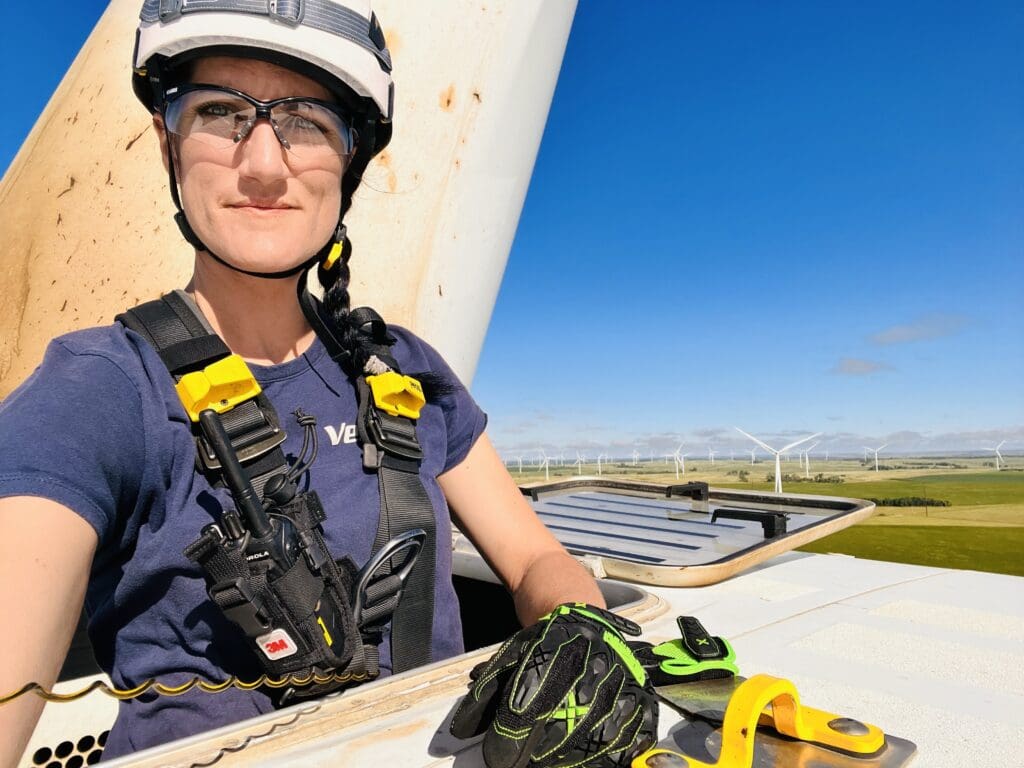

Background
Could you give a brief description of your background?
I was born in Colorado and grew up in Pennsylvania for most of my early childhood. Then I moved out to California with my family and stayed there till I was in my 20s.
After my 20s I spent a lot of time traveling and acquiring skills in different trades while trying to also find where my “home” would end up being.
I have 2 children, a son and a daughter. I have been a single parent for over 5 years now so being the primary provider has always driven my career path. Before joining the wind industry, I was working two jobs, 18 hours a day driven primarily by the high rise in the cost of living. I was looking for a job that would help sustain my family, but also give me the opportunity to be there for them as well.
Working in construction
How did you start your career in construction?
My construction career path started when I took a pre-apprenticeship position with my dad who was a general foreman pipefitter. I had always been a technically minded person, who enjoyed building things and working with my hands. Although that specific trade was not where my interest lay, I knew that I wanted to work in a field that built things for the future.
A lot of my work experience was on the administrative side of things, some positions were more hands on than others, but I always stayed in a branch of construction.
Prior to joining Vestas, I was driving forklifts for a logistics company. My job involved loading and unloading trucks as a part of the transportation department. My other job at this time was as the administrator for a custom closet company. I also owned my own small business as a Notary Public for the State of Oregon.
Transitioning to the wind power industry
How did you decide to move into the wind power industry?
I had come across an application for a program through Vestas called the “Technician Readiness Program” which offered training and relocation. Although, I had a very limited and basic knowledge of wind turbines at the time, I felt it would be a great industry to be a part of. I was lucky enough to be selected to participate in this program in April 2023 and recently completed training and have been working on site ever since. I finally feel like I am home, and in a career that I love and am happy to be a part of every day.
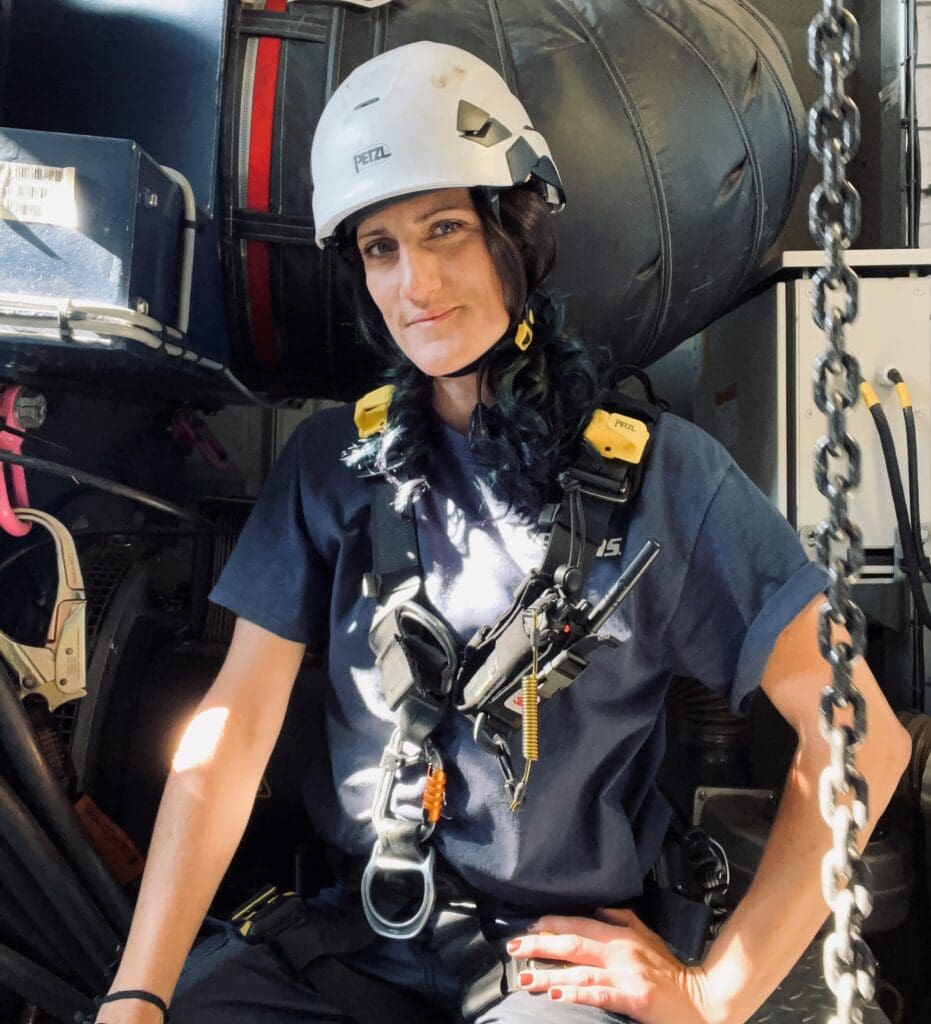

Were there any childhood interests which were a factor in your career choice?
As a child I was always tinkering with things, taking them apart to see how they worked, or trying to build the things I didn’t have. I loved to hang out with my dad while he was working on cars or doing renovations on the house. If something was broken, my dad found a way to fix it. If work needed to be done, he was always the one doing it. I did my best to mirror my work ethic after him.
Love of the outdoors
Have you always liked being outside and active?
Being active is all I’ve ever known, I am a high functioning person, and if anything, have always found being idle very difficult. Growing up we didn’t have as much distracting technology as society currently has for children, so most of my childhood was spent out in nature. So much so, that as I grew up and our family moved to the city, I found more idle time indoors and less chance to explore outdoors. This drove me to do more projects, like renovating furniture I had found at thrift stores, or learning computer coding. I believe part of my interest in working in the construction field, was the ability to be outside and have different scenery to experience and explore.
Role models and inspirations
Who were your inspirations or role models?
My role model is and always has been my mother. She is one of the hardest working people I’ve ever known, I’ve seen her overcome adversity many times, always fighting for the best life she could give to me and my siblings. There were not many things she was unwilling to do when it came to providing for her family. She went back to college and currently works as an Interior Designer in San Diego, California. She has raised six kids each with their own special skills and success. My mother gave us all a life, despite the odds, that any child could hope for. It is through watching her struggles and the way she overcame them, that I learned that same strength in my own life. Her legacy is the will to preserve, never give up, and always fight for the life you deserve.
Transferable skills
You worked in construction before moving to the wind turbine industry. Which technical skills did you take with you?
Through the various construction industry positions I’ve held, the technical skills I’ve acquired and used through each job and after are:
the ability to use and operate various types of power tools and
machinery,
to drive a forklift,
general blueprint interpretation,
painting,
drywalling,
flooring,
basic electrical processes,
knowledge of safety protocols and procedures.
Which soft skills transferred?
The soft skills I have learnt are:
analytical reasoning,
problem solving,
the ability to listen and understand,
being open and willing to accept constructive criticism, adaptability,
commercial awareness,
and above all things – teamwork.
You have also worked in administration. What skills did you take from this role which are useful now?
The administrative roles have taught me how each side of a business operates and what things are needed from a team/company as a whole to be successful.
The roles also taught me emotional intelligence and how to engage with the person/customer you’re working with, as well as conflict resolution, strategic planning, and resourcefulness. A lot of administrative work is centred around customer satisfaction which has many different unseen sides to it, so awareness of expectations and audience was a necessary tool for success. All of these tools are useful in all aspects of life whether on site or at home.


Women in Science and Engineering
You have worked in teams where you are the only woman, or one of the only women. How do you handle this situation? Do you think diverse teams are more successful?
Yes, I have actually come to prefer working in fields that are generally male dominated. I think diverse teams are essential in all trades for balance. I am aware that I have a strong eye for attention to detail, but also can over think things. Adding the balance of another gender helps to strengthen the team’s current skill set. The best way to handle any situation is with unconditional positive regard for all, and a hardworking mindset.
What would you say to a woman who is considering working in the wind power industry?
I’d really encourage them to consider a career in wind power and to not let any fears they may have to dissuade them from their own personal ability to be anything they want to be in this world. This is an industry that needs more women but is also a great trade for women. There is a strong safety culture in this industry, more so than the others I’ve had experience with. The real advance of the world will start to change as we bring more balance into these workplaces where women are very much needed.
Changes over the next ten years
You are working in a male dominated industry. How do you think it will change over the next ten years?
I think there is a lot of growing support and understanding in the wind industry that women are a valuable yet uncommon asset. There are a lot of great programmes running in the US and the UK that were designed to create more opportunities and interest for women to work with wind turbines.
There is a great need for strong individuals within our current society. I believe there are currently a good number of opportunities that are being provided to both women and men. However, for reasons I can only guess on, women are overlooking opportunities that they are capable of being successful in.
Over the next ten years, I believe the best thing we can do for women in the industry is understanding what barriers they have and finding out how to overcome those barriers for them to have the opportunity to get into the wind Industry. It may be possible that women’s ability to be in male dominated fields could come down to the barriers they face more so than their counterparts, and overcoming those barriers is the key to getting more women more opportunities.
Physical fitness
How important is physical fitness at work for you?
Physical fitness at work is a huge priority. Working out in nature means being aware of how the current weather could affect you physically.
It’s always important to stay hydrated during the warmer days for example. It can feel hotter up tower than it would down tower, and staying hydrated is a huge priority in situations where you’re working in high temperature environments.
The same is true for cold weather as well.
Another important factor is sleep. Making sure you get enough sleep every day is important if you wish to perform well at any job you are doing. Making good decisions the night before is important for continued work productivity.
It is important to recognize that your ability to perform a rescue in a worst-case scenario will come down to how you take care of your body. So, that is important for the continued safety of yourself and your team.
Personal physical fitness
How do you personally cope with the physical demands of working on wind turbines?
There are a lot of physical differences between all people. Some may be taller or shorter, some people may find they have more leg strength than arm strength or vice versa.
I had breast cancer a few years ago, and due to different surgeries and the healing process, I did temporarily loose some of my upper body strength. This is something I continue to try and build back every day.
The way that I overcome obstacles with physical demands of working on a wind turbine, is by using the tools and skills at my disposal to compensate for things I may not be able to complete on my own.
For example, If I am unable to lift an accumulator for an exchange, I can use the crane up tower, or ask my other team members for support. There should never be any barriers when asking for help. There are many different tools that can be used to offer support, it’s all about using your creativity and knowledge base to come up with different ways to complete the task at hand. This was a skillset I learned during my Advanced Rescue Training. I also keep an active and healthy lifestyle which supports my body and ability to regain and build strength.
Working at heights
Can you describe the first time you worked at height?
While I realise there are a great many people who are afraid of heights, I have never felt like this but rather been in awe of heights. The perspective you can get of the world around you from different heights is not at all comparable to the view from the ground.
My first time at heights was during my Climb Test. Climb assist is not used during the test, so free climbing as a first experience was a great way to test my own ability to climb at heights. It was challenging but extremely rewarding when I finally made it up tower.
Are you trained to rescue at heights?
After this I had training and practice performing rescues at heights. It did take me quite a few days and repetition to feel confident with my ability to perform a rescue at height, but confidence is usually built in practice.
When I finally had my first up tower working at heights experience, I felt very confident simply being at heights. Once you are up tower, performing the work becomes its own separate task. The height aspect doesn’t cross your mind until you are either on top of the tower or coming back down it.
Types of work
Do you work on the blades?
There are different areas of the wind industry where rope access becomes a different job. There are technicians who work outside of the turbine for example, on the blades. In my role, I spend more time working within the nacelle as opposed to outside of it. I do have a lot of interest for the future in obtaining rope access and training or working on offshore turbines, which of course would involve a different aspect of working at heights.
Can you work in the wind turbine industry without much time spent at heights?
Yes, individuals who have a hesitation about working at heights, can still find many jobs within the industry that don’t require as much exposure to the heights quotient if they so choose.
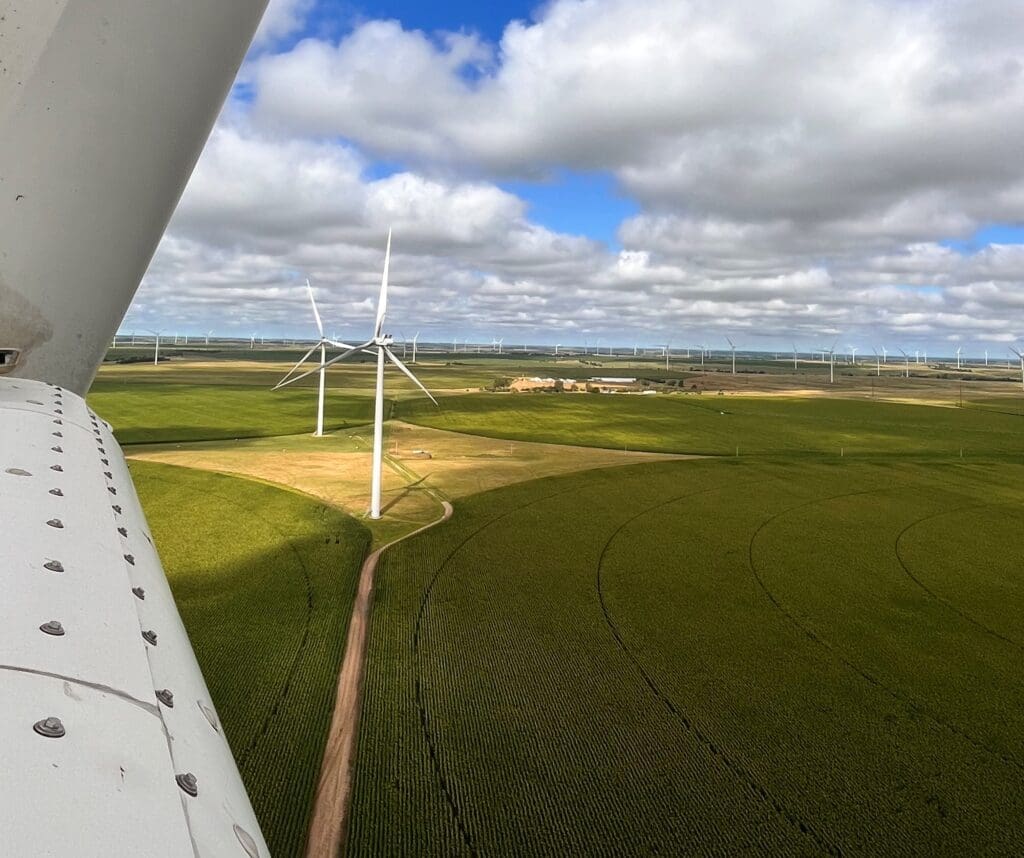

Confidence and advice
How quickly did you become confident?
I’d say that I’m still building confidence every day and my growth in confidence comes from my willingness to learn. I know so long as I am willing, I can overcome any obstacle and learn any skill set provided to me. There is still so much I don’t know and so much still to learn. I am blessed to work in a company that provides extensive training opportunities for people who want to expand their skill set at their own pace and a need for people who are trained in different sides of the industry.
What advice would you give someone in their first three months of working at heights?
Embrace your training and trust your PPE. Training will help build your confidence and the knowledge of hazard mitigations can be essential to your safety and success.
Safety clothing
What sort of safety clothing, footwear, headwear and harnesses do you need to wear?
As a wind turbine technician, we wear many different types of Personal protective equipment (PPE) for our safety.
ARC Rated clothing provides insulation from burn exposure. Steal Steel/Composite Toe Boots to withstand impact or punctures from sharp or falling objects.
A hard hat to protect you from potential injury from a falling object or low hanging beams or equipment within the turbine.
There are many different styles of harness, but the harness is essential to prevent an injury from a fall from heights. I wear the Petzl AVAO Bod Fall Arrest. I prefer this style as I feel it is better suited to my body. However, there are different styles for different preferences and work environments.
We also wear safety glasses and a variety of different gloves designed for different types of work.
Other PPE options include ear plugs, masks, or Tyvek suits depending on the work to be performed.
Are there challenges finding things which fit well and are comfortable? (Are most things designed for men?)
There are a great deal of challenges when finding things that fit well, are comfortable, and fit my style preference.
Trousers
I have found that finding consistently sized trousers to be the most challenging even when “designed for women”. Trousers tend to be too small in the waist, too short in length, or too big overall.
Pockets on these trousers are also not designed as well as they could be. Ensuring things don’t fall out of your pockets while you’re working is a huge safety concern if the trouser pockets have not been designed well. I have tried ordering different sized men’s trousers as well as women’s, and each comes with a huge size variation.
Boots
The choice for women’s boots is very slim, I ordered a pair of men’s boots and found them to be extremely heavy.
Harness
I have also found it difficult to find a harness specifically designed for women. Generally speaking the majority of harnesses have been too big for me.
Undergarments
Another challenge I have found is finding ARC Rated undergarments. It is suggested to wear this type of underwear when wearing ARC rated clothing, or at the very least cotton undergarments. I have found little to no options for ARC rated bras or underwear.
Despite some of these difficulties, I have found some of the men’s clothing to fit, or that I prefer it over the options created for women.
Heat and cold
How do you personally cope with the heat and the cold?
Currently we are working in heat. The company I work for provides and requires water cases to be brought up tower, as well as electrolyte popsicles (ice lollies) as an option for hydration.
It is important to know that staying hydrated means drinking water the night before, not just while you’re working.
Fans have also been provided to bring up tower to help with the heat.
Buddy checks with your fellow co-workers are essential when working in any kind of harsh weather environment. Asking your co-worker if they’d like a water, or checking in with them to see how they are feeling is important to keep everyone safe.
There are also similar options provided when working with the cold such as heaters, winter wear; coveralls, insulated jackets, pocket warmers, gloves, and ARC rated thermal clothing.
Clothing advice to women wind turbine technicians
What clothing and footwear advice would you give to other women wind turbine technicians?
I would recommend trying on different sized men’s clothing and footwear to gauge correct sizing between women’s and men’s. We need to do this until more options are created for women.
At the end of the day what is most important is safety, so having something that fits comfortably and provides the necessary safety is the highest priority.
Other women turbine technicians with the knowledge and motivation would be great leaders in the PPE industry as well. So my secondary advice would be for women to come together and design more PPE designed for the fit and comfort of women with the knowledge of what works best within our industry.
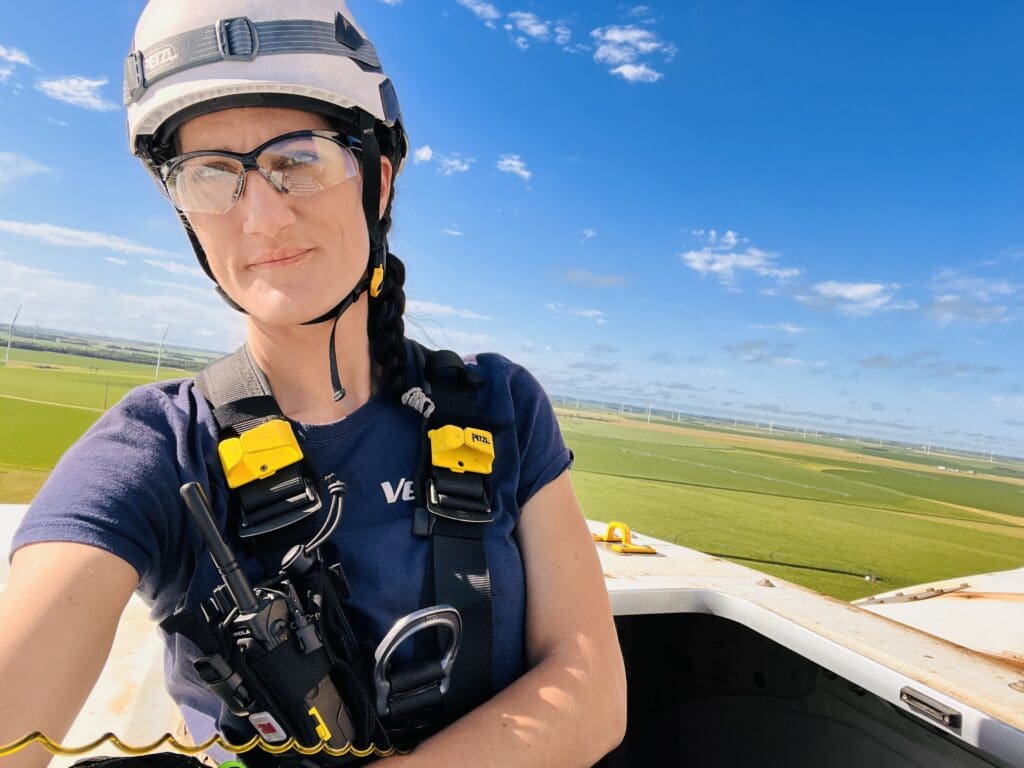

New wind turbine technicians
What are the three most important skills to have?
Good work ethic,
desire to learn,
and a safety conscious mindset.
What are the key things to do in your first month?
Watch how the work is performed, ask a lot of questions, and always be prepared for a rescue. It’s no one’s wish in this industry to perform a rescue or have to witness an injury. However, being prepared for it is something you should always keep in the back of your mind from Day 1.
What are the key things to do in your first year?
Obtain as much training as you can.
Think about where you would like your career to be focused within the industry and work towards that every day.
The wind industry is growing constantly, and being a part of the growth is exciting and has an endless number of opportunities. Having your mind set on a goal will help keep you engaged and motivated with your job and journey in the wind industry.
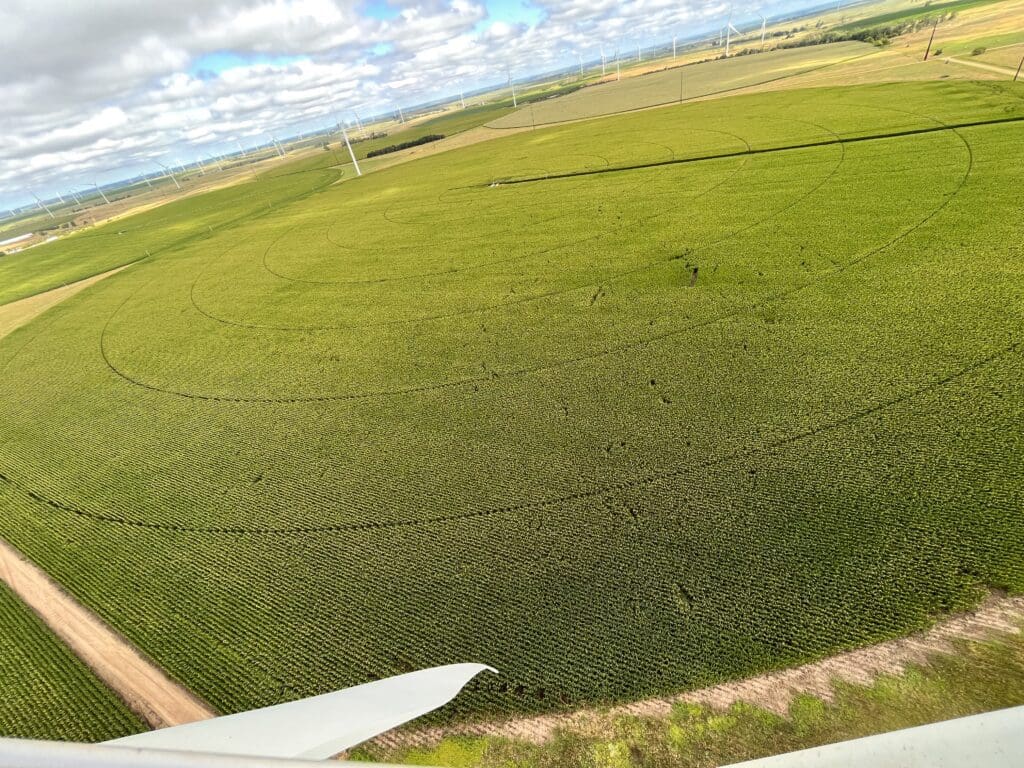

Further reading
Michael Martin – Wind Turbine Technician and Technical Writer.
Gökhan Oruç on becoming a Wind Turbine Technician.
Jessie Moffitt, Wind Turbine Technician for Fairwind in the United States.
Field Service Specialist Michiel Lamens keeping offshore cranes working all over the world.
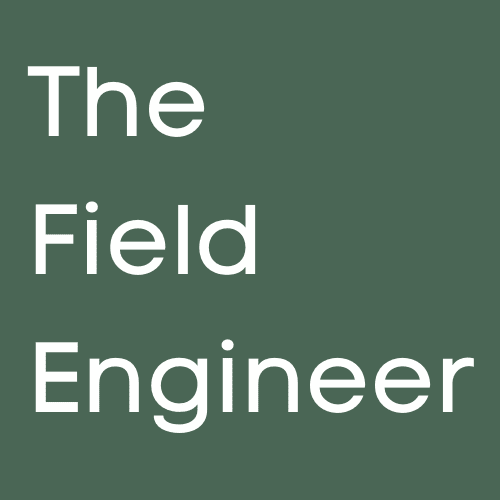

Responses